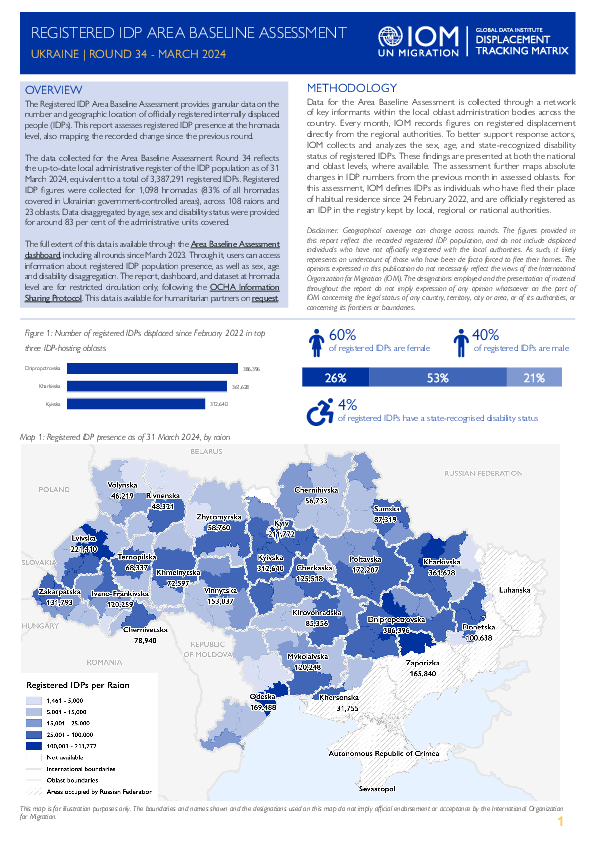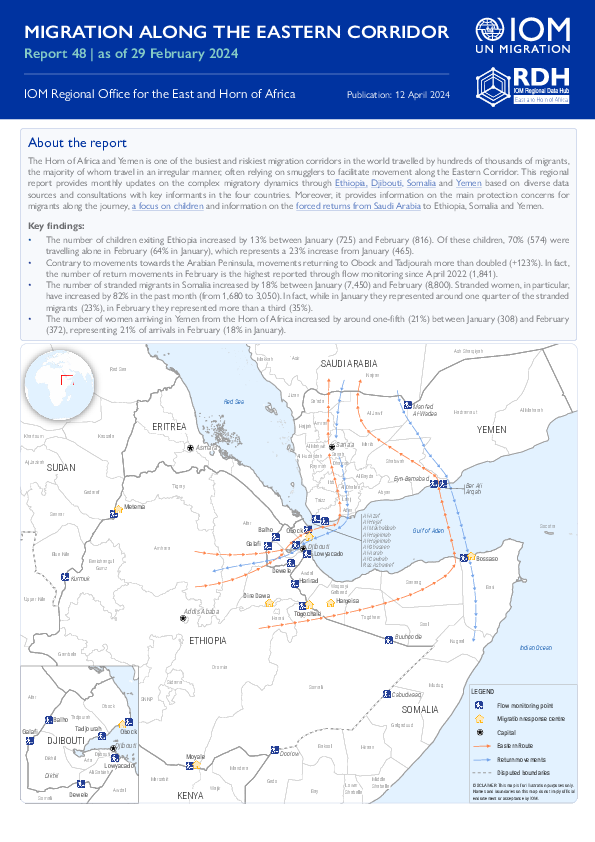-
Countries
-
Data and Analysis
-
Special Focus
-
Crisis Responses

Contact
DTM Europe, DTMMediterranean@iom.int
Language
English
Location
Latvia
Period Covered
Jan 01 2023
Dec 31 2023
Activity
- Survey
From January to December 2023, Displacement Tracking Matrix (DTM) gathered information on the Needs, Intentions, and Integration Challenges faced by Ukrainian refugees in Latvia, conducting interviews with a total of 1,155 individuals throughout the year. This report explores the employment profiles and prospects of the adult respondents, with a special focus on those who have either expressed an intention to stay or have already established themselves in the country (N=171). These individuals, referred to as ‘stayers’ in this study, are actively investing their human and social resources to fully integrate into the host community. The report further narrows its analysis to a subset of 155 respondents who are within the working age bracket (18-64 years old), offering insights into their involvement in the labour market and detailing their experiences, needs, and intentions concerning employment in Latvia for the duration of their displacement.

Contact
dtmukraine@iom.int
Language
English
Location
Ukraine
Snapshot Date
Mar 01 2024
Activity
- Survey
Revisions to the eligibility criteria that came into effect in March 2024 limited access to the IDP living allowance based upon a specific set of socio-economic vulnerability profiles. This introduction of additional criteria is intended to ensure that social assistance in Ukraine is capable of supporting the most vulnerable, both among those who have been displaced and the general population. However, this increases the risk of excluding some vulnerable individuals who may lose access to the IDP living allowance under the new criteria. This reduction in monthly household income could impact on the ability of vulnerable households to meet their basic needs and rebuild their lives.
The purpose of this brief is to provide an overview of the estimated share and number of IDPs that may still be eligible for the IDP allowance under the new policy. Using available secondary data, this thematic brief aims to provide an indicative overview of the share and number of IDPs that will not be eligible anymore, despite being vulnerable to a reduction in household income that could affect their ability to meet basic needs. The brief intends to inform and support advocacy and programming of humanitarian partners in complementarity with the new IDP allowance scheme.

Contact
DTMUkraine@iom.int
Language
English
Location
Ukraine
Period Covered
Mar 01 2024
Apr 30 2024
Activity
- Baseline Assessment
The Registered IDP Area Baseline Assessment provides granular data on the number and geographic location of officially registered internally displaced people (IDPs). This report assesses registered IDP presence at the hromada level, also mapping the recorded change since the previous round.
The data collected for the Area Baseline Assessment Round 34 reflects the up-to-date local administrative register of the IDP population as of 31 March 2024, equivalent to a total of 3,387,291 registered IDPs. Registered IDP figures were collected for 1,098 hromadas (83% of all hromadas covered in Ukrainian government-controlled areas), across 108 raions and 23 oblasts. Data disaggregated by age, sex and disability status were provided for around 83 per cent of the administrative units covered.

Contact
DTM Sudan; dtmsudan@iom.int
Language
English
Location
Sudan
Period Covered
Apr 15 2023
Apr 04 2024
Activity
- Mobility Tracking
- Baseline Assessment
To mark one year since the outbreak of conflict in Sudan, this report analyses the evolution of displacement based on DTM data collected throughout the past year of conflict.
An interactive Story Map presenting more granular data is available here.
Key Findings:
- An estimated 6,657,550 individuals were displaced internally within Sudan since the start of the conflict one year ago, on 15 April 2023.
- Approximately 2,044,248 individuals were reportedly displaced across borders into neighbouring countries.
- An estimated 13 per cent of the population in Sudan was displaced during the past year of conflict.
- Over half (approximately 53%) of individuals internally displaced were children, under the age of 18 years old. Approximately 22 per cent were children under the age of 5 years old.
- Approximately 10 per cent of localities across Sudan experienced a population increase of 50 per cent or higher due to the influx of displaced individuals, exacerbating pressure on already-limited resources and services.
- Sudan hosted approximately 13 per cent of all internally displaced persons globally, and nearly 1 in every 8 internally displaced persons worldwide is Sudanese.
- Approximately 28 per cent of displaced individuals were female children under the age of 18, who faced unique protection risks.

Contact
DTM Uganda, dtmuganda@iom.int
Language
English
Location
Uganda
Period Covered
Mar 01 2024
Mar 31 2024
Activity
- Mobility Tracking
- In March there were reports of affected people due to Heavy Storms or Hailstorms in the districts of Kanungu (8,620), Namisindwa (825), Bunyangabu (580), Buikwe (262), Mubende (40) and Wakiso (25). In Kampala (24) and Bundibugyo (5) were reports of affected people due to fires, while in Buikwe nine people were affected by a transport-related accident.
- The impacts of the hazards affected 10,390 individuals (2,387 households), with 426 people from 91 households were internally displaced. Children below the age of 18 were the most affected age group (67%), followed by adults (18-64) at 30% and elderly above 64 (3%). Notably, more than half of affected people were female (62%).
- Urgent needs identified include sanitation, nonfood items, food assistance among others. Infrastructure damage assessed indicated that 213 houses were partially damaged, 41 houses were completely destroyed, 5 schools, 1 water facility and 1 health facility were affected.

Contact
DTM Haiti, dtmhaiti@iom.int
Language
French
Location
Haiti
Period Covered
Mar 08 2024
Apr 09 2024
Activity
- Survey
- Flow Monitoring Survey
- Flow Monitoring
Since end of February 2024, the security situation has deteriorated in the Metropolitan Area of Port-Au-Prince (MAPAP), the capital of Haiti. In addition to creating displacement within the MAPAP, generalized insecurity are pushing more and more people to leave the capital to find refuge in provinces, taking the risks of passing through gangs-controlled routes. In order to monitor these movements towards provinces and inform appropriate response strategies, DTM has launched data collection at several of the most used bus stations in the capital (see page 5 for more details on the methodology). In one month of implementation of this activity (since 8 March), movements of 94,821 people leaving the MAPAP have been observed (see pages 3 and 4 for more details on their profile). The majority of them (58%) took means of transport heading towards the Grand Sud departments (Grande’Anse, South, Nippes and South-East). It should be noted that this region already hosts more than 116,000 people who had in vast majority, fled the MAPAP in recent months (see the report on displacement in the Grand Sud). Half of flows headed towards 3 main destination municipalities: Jérémie (in Grande’Anse), Les Cayes (South) and Léogâne (West).
It should be emphasized that provinces do not have sufficient infrastructures and host communities do not have sufficient resources that can enable them to cope with these massive displacement flows coming from the capital.
It should be noted that at the beginning of March, when the security situation worsened, people who were already internally displaced (IDPs) were the first to begin leaving the capital. Over time, more and more people who were not IDPs are also leaving: as of 10 March, 86% of people leaving the MAPAP were IDPs. One month later, this percentage dropped to 60%, while almost 40% were those who had never fled their residence and who decide to leave it and seek refuge in provinces. This further describes the deterioration of the situation in the capital, given that leaving the capital could be a relatively quicker decision to make for a person who was already displaced than for someone who was still in their residence and decides to leave it for seek refuge in provinces.

Contact
DTM Nigeria, iomnigeriadtm@iom.int
Language
English
Location
Nigeria
Period Covered
Apr 01 2024
Apr 07 2024
Activity
- Mobility Tracking
- Event Tracking
Between 1 and 7 April 2024, a total of 1,223 new arrivals were recorded at locations in Adamawa and Borno states. The new arrivals were recorded at locations in Askira/Uba, Bama, Chibok, Damboa, Dikwa, Gwoza, Kaga, Kala Balge, and Monguno Local Government Areas (LGAs) of the most conflict-affected Borno State, and in Fufore, Girei, Gombi, Hong, Madagali, Maiha, Michika, Mubi North, Mubi South, Numan, Song, Yola North and Yola South LGAs of Adamawa State.
ETT assessments identified the following movement triggers: family re-unification (407 individuals or 33%), poor living conditions (261 individuals or 21%), improved security (176 individuals or 14%), fear of attack (175 individuals or 14%), military operations (94 individuals or 8%), access to humanitarian services (56 individuals or 5%) and seasonal farming (54 individuals or 5%).

Contact
DTM Burundi, DTMBurundi@iom.int
Language
French
Location
Burundi
Period Covered
Mar 31 2024
Apr 07 2024
Activity
- Mobility Tracking
- Event Tracking
La DTM a identifié 16 182 personnes affectées et 832 personnes déplacées par les inondations, les pluies torrentielles, et les glissements de terrain.
• The number of children exiting Ethiopia increased by 13% between January (725) and February (816). Of these children, 70% (574) were
travelling alone in February (64% in January), which represents a 23% increase from January (465).
• Contrary to movements towards the Arabian Peninsula, movements returning to Obock and Tadjourah more than doubled (+123%). In fact,
the number of return movements in February is the highest reported through flow monitoring since April 2022 (1,841).
• The number of stranded migrants in Somalia increased by 18% between January (7,450) and February (8,800). Stranded women, in particular, have increased by 82% in the past month (from 1,680 to 3,050). In fact, while in January they represented around one quarter of the stranded migrants (23%), in February they represented more than a third (35%).
• The number of women arriving in Yemen from the Horn of Africa increased by around one-fifth (21%) between January (308) and February
(372), representing 21% of arrivals in February (18% in January).

Contact
DTM Burundi, DTMBurundi@iom.int
Language
English
Location
Burundi
Period Covered
Feb 01 2024
Feb 29 2024
Activity
- Mobility Tracking
- Baseline Assessment
IOM’s Displacement Tracking Matrix is a comprehensive system to analyse and disseminate information to better understand the movements and needs of Internally Displaced Persons (IDPs) in Burundi. The baseline assessment aims at providing information on the stock (presence) by colline of IDPs which are categorized into two groups: Internally Displaced Persons (IDPs) including IDPs who returned to their colline of origin but not their home and returnees who became IDPs. The baseline assessment also collects information on the cause of displacement and the type of shelter hosting IDPs. Data collection is conducted four times per year by trained Burundian Red Cross volunteers operating at all administrative levels: provinces, communes and collines.
